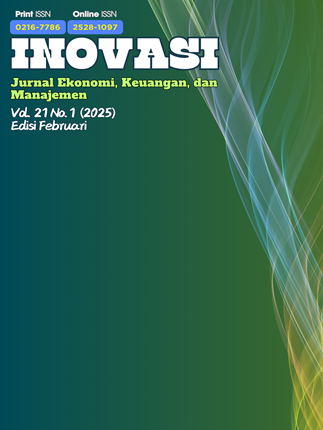The Effect of Money Supply and Interest Rates on Inflation in Indonesia
DOI:
https://doi.org/10.30872/jinv.v21i1.3504Keywords:
Inflation, Money Supply, Interest RateAbstract
The determinant of a country with a stable economy is measured by the inflation rate which is the main factor in economic development, Inflation is a situation where price increases occur continuously in one period. The purpose of this study is to see the influence of Money Supply and Interest Rates in Indonesia. This research method uses ECM (Error Correction Model) and the data used is data from the period 2005 – 2020. The results of this study show that the Money Supply has a significant effect on Inflation. For interest rates, it shows results that have a significant effect on inflation. Based on the results of the study, in the long term the variable amount of money supply (X1) has no effect on the variable inflation (Y) in Indonesia, while in the short term the amount of money supply has an effect on inflation in Indonesia. For the Variable Interest Rate (X2) both in the long and short term it affects the inflation variable (Y) in Indonesia
References
Abdurehman, Abderezak Ali and Samet Hacilar. 2016. The Relationship between Exchange Rate and Inflation: An Empirical Study of Turkey. International Journal of Economics and Financial Issues. 6(4), pp:1454-1459
Alvyonita, Maria and Paidi Hidayat. 2012. Causality Analysis between BI Rate and Money Supply in Indonesia. Available at: https:// www.neliti.com/publications/14819/analisis-kausalitas-antara-bi- rate-with-quantity-money-circulating-in-indonesia. Access date : August 24, 2021.
Andrianus, Fery and Amelia Niko. 2006. Analysis of Factors Affecting Inflation in Indonesia for the Period 1997:3 – 2005:2. Available on: https://journal.uii.ac.id/JEP/article/view/533/445. Access date : September 2, 2021.
Bank Indonesia. 2018. Available At: https:// www.bi.go.id/id/fungsiutama/moneter/inflasi/default.aspx. Access Date: August 27, 2021
Central Statistics Agency. BI Rate Data 2005 – 2020. 2021. Available On: https:// www.bps.go.id/indicator/13/379/5/bi-rate.html. Access Date: August 28, 2021.
Case, Karl E. and Ray C. Fair. 2006. Economic Principles. Jakarta: Erlangga Publishers
Djohanputro, Bramantyo. 2006. Principles of Macroeconomics. Print I. PPM. Jakarta.
Dumairy. 1987. The Causality Between Money Supply and Inflation in Indonesia. Journal of Indonesian Economics and Business. Available on: https://jurnal.ugm.ac.id/jieb/article/view/40354/22673. Access Date : August 24, 2021.
Ferdiansyah, Fadli. 2011. Analysis of the Influence of Money Supply (M1), SBI Interest Rate, Deposit Interest Rate Exchange Rate on Inflation Rate. Available on: https:// www.trijurnal.lemlit.trisakti.ac.id/medek/article/view/771/683. Access date : September 2, 2021.
Hello, Jimmy. 2014. Monetary Economics. Yogyakarta: Deepublish.
Insukindro (1999), "Selection of Empirical Economic Models with a Error Correction Approach", Indonesian Journal of Economics and Business, Vol. 14, No. 1: 1-8.
Kaplan, Fatih and Sule Gungor. 2017. The Relationship Between Money Supply, InterestRate and Inflation Rate: an Endogeneity-Exogeneity Approach. European Scientific Journal. 13(1), pp:1857 – 7881
Khalwaty, Tajul. 2000. Inflation and Its Solutions. Jakarta: PT Gramedia Pustaka Utama.
Maddala, G.S (1992). Introduction to Econometric, 2nd Edition, Mac-Millan Publishing Company, New York.
Maggi, Rio, and Birgitta Dian Saraswati. 2013. Factors affecting Inflation in Indonesia: Demand Pull Inflation Model. Journal of Applied Quantitative Economics. Vol. 6 No. 2, p:71-77 ISSN 2421-2429 Available on: <https://ojs.unud.ac.id/index.php/jekt/article/view/7438>. Accession Date: August 25, 2021
Mishkin, Frederic S. 2008. Money Economics, Banking, and Financial Markets. Jakarta: Salemba Four.
Nachrowi, D.N. and H. Usman (2002). Use of Econometric Techniques. Jakarta: PT Raja Grafindo Persada.
Ningsih, Suhesti and LMS Kristiyanti. 2018. Analysis of the Influence of Money Supply, Interest Rate, and Exchange Rate on Inflation in Indonesia for the Period 2014 – 2016. Available at: https://sinta.ristekbrin.go.id/authors/detail?id=5974405&view=documents gs . Access date : September 2, 2021.
Nopirin. Monetary Economics. 2000. BPFE UGM. Yogyakarta.
Polontalo, Fahrurrazi, Tri Oldy Rotinsulu, Mauna Th.B Maramis. 2018. Analysis of Factors Affecting Money Demand in Indonesia for the Period 2010.1-2017.4. Scientific Periodic Journal of Efficiency. Available on: https://ejournal.unsrat.ac.id/index.php/jbie/article/view/20264. Access Date : August 25, 2021
Symbols, Heru. 2012. Analysis of the Influence of Money Supply, SBI Interest Rate, Exchange Rate on Inflation Rate. Available on: https://sinta.ristekbrin.go.id/journals/detail?id=5330. Access date : September 2, 2021.
Solikin and Suseno. 2001. Money: Definition, Creation, and Its Role in the Economy, 2002. Center for Central Banking Education and Studies (PPSK). Jakarta.
Stuart Arif.1993. Economic Research Methodology. BPFE, Yogyakarta. Squirrel, Sadden. 2004. Macroeconomics Theory Introduction, PT. Raja Grafindo Persada, Jakarta.
Thomas, R.L. 1998. Modern Econometrics : An Intoduction. Addison-Wesley. Harlow, England
Widarjono, Agus, Econometrics Theory and Applications for Economics and Business, Second Edition, First Printing, Economics Publisher, Faculty of Economics, UII Yogyakarta 2007.
Yuliadi, Imamudin. 2008. Monetary Economics. Jakarta: PT Indeks.
Downloads
Published
Issue
Section
License
Copyright (c) 2025 Marla Pisganidy, Muhammad Awaluddin

This work is licensed under a Creative Commons Attribution-ShareAlike 4.0 International License.






